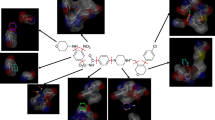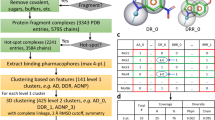Abstract
We report a set of strategies to develop novel ligands (Structure Based and Experimental Selection of Fragments: SbE-SF). First, a docking simulation utilizing DOCK3.5 is performed in order to screen the fragment database, which was generated with the in-house program FRAGMENT++ specifically for docking simulation purposes. Although the affinity of these small molecules (fragments) is expected to be low, the affinity of fragments selected by computation is assayed by experiment to determine which ones can be potent inhibitors. After determining such key fragments, additional fragments are attached to the key ones in order to increase the binding affinity,taking into account the binding modes predicted by computation. This method has been applied to a thrombin inhibitor study, resulting in the discovery of a novel inhibitor exhibiting pIC50 = 7.9.
Similar content being viewed by others
References
Mizutani, M.Y., Tomioka, N. and Itai, A., J. Mol. Biol., 243 (1994) 310.
Rarey, M., Kramer, B., Lengauer, T., Klebe and G., J. Mol. Biol., 261 (1996) 470.
Welch, W., Ruppert, J. and Jain, A., Chem. & Biol., 3 (1996) 449.
Makino, S. and Kuntz, I.D., J. Comp. Chem., 18 (1997) 1812.
Available Chemical Directory (ACD) available from Center for Scientific Computing (CSC), Tekniikantie 15 a D,Otaniemi, Espoo, Finland.
e.g. Available Chemical Directory (ACD), MDL Drug Data Report (MDDR), National Cancer Institute (NCI) are available from Center for Scientific Computing (CSC), Tekniikantie 15 a D,Otaniemi, Espoo, Finland.
Nishibata, Y. and Itai, A., J. Med. Chem., 36 (1989) 2921.
Moon, J.B. and Howe, W.J., Proteins, 11, (1991) 314.
Roe, D.C. and Kuntz, I.D., J. Comp. Aid. Mol. Des., 9 (1995) 269.
Böhm, H.-J., J. Comp. Aid. Mol. Des., 10 (1996) 265.
Kick, E.K., Roe, D.C., Skillman, A.G., Liu, G.C., Ewing, T.J.A., Sun, Y., Kuntz, I.D. and Ellman, J.A., Chem. Biol., 4 (1997) 297.
Shuker, S.B., Hajduk, P.J., Meadows, R.P. and Fesik, S.W., Science, 274, (1996) 1531.
Fejzo, J., Lepre, C.A., Peng, J.W., Bemis, G.W., Ajay, Murcko, M.A. and Moore, J.M., Chem. Biol., 6 (1999) 755.
SYBYL, Version 6.0.2, Tripos Associates, St. Louis, MO, 1993.
SYBYL Programming Language (SPL), Tripos Associates, St. Louis, MO, 1993.
Available from ftp://ftp.gnu.org/pub/gnu/gcc.
Kaiser, B., Drugs Future, 23 (1998) 423.
Protein Data Bank, Chemistry Department, Building 555, Brookhaven National Laboratory, Upton, NY 11973.
Dyke, S. F. and Kinsman, R. G., in Weissberger, A. and Yaylor, E.C. (eds), The Chemistry of Heterocyclic Compounds, Vol.
38 John Wiley & Sons, New York, NY, 1981; p. 8.
Sturzebecher, J., Vieweg, H., Wikstrom, P., Turk, D., and Bode, W., BiolChem. Hoppe-Seyler, 373 (1992) 491.
Because this program is still under active development, interested readers should contact the authors concerning its availability.
SLN Manual, Tripos Associates, St. Louis, MO, 1993.
SYBYL, Version 6.02, Tripos Associates, St. Louis, MO, 1993.
Gasteiger, J. and Marsili, M., Tetrahedron, 36 (1980) 3210.
Banner, D.W. and Hadvary, P., J. Biol. Chem., 266 (1991) 20085.
Docking simulations with various charge models were performed without finding significant difference in the results.
SYBYL Command Manual, Tailor:MAXIMIN2, Tripos Associates, St. Louis, MO, 1993.
DOCK3.5 manual, Edited by D. A. Gschwend, Department of Pharmaceutical Chemistry, University of California, San Francisco.
DOCK3.5 manual, p. 13.
Hara, T., Yokoyama, A., Ishihara, H., Yokoyama, Y., Nagahara, T. and Iwamoto, M., Thrombosis Haemostasis, 71 (1994) 314.
Brandstetter, H., Kuhne, A., Bode, W., Huber, R., Saar, W.V.D., Wirthernsohn, K. and Engh, R.A., J. Biol. Chem., 271 (1996) 29988.
Although affinities of several fragments for thrombin were determined experimentally, the affinity of all the fragments other than benzamidine were not determined for FXa (pIC50 < 2.0).
Makino, S., Ewing, T.J.A. and Kuntz, I.D., J. Comp. Aid. Mol. Des., 13 (1999) 513.
CAESA by Peter Johnson, http:// www.chem.leeds.ac.uk/ICAMS/new_web/CAESA/ caesa.htm.
Nakagawa, T., Makino, S., Sagi, K., Takayanagi, M. and Kayahara, T., New Inhibitors of FXa, Patent WO99-47503.
Nakagawa, T, Makino, S., Sagi, K., Takayanagi, M., Yamanashi, M., Yoshida, K., Yukuda, Y., Ishikawa, K., Kayahara, T., Takehana, S., Takahashi, M., Tsuji, T. and Shoji, M., J. Med. Chem. (submitted).
Author information
Authors and Affiliations
Rights and permissions
About this article
Cite this article
Makino, S., Kayahara, T., Tashiro, K. et al. Discovery of a novel serine protease inhibitor utilizing a structure-based and experimental selection of fragments technique. J Comput Aided Mol Des 15, 553–559 (2001). https://doi.org/10.1023/A:1011196407163
Issue Date:
DOI: https://doi.org/10.1023/A:1011196407163




